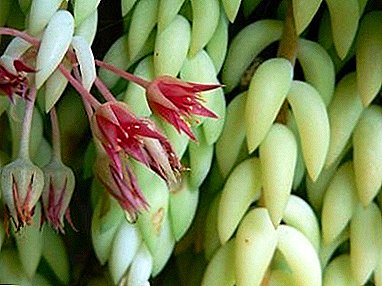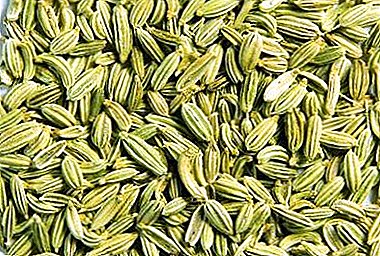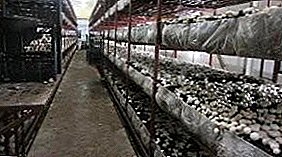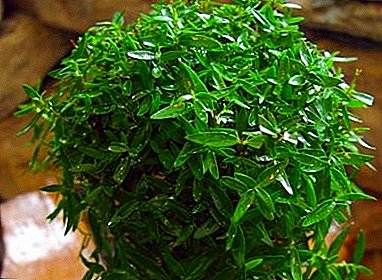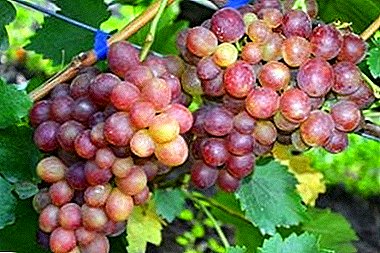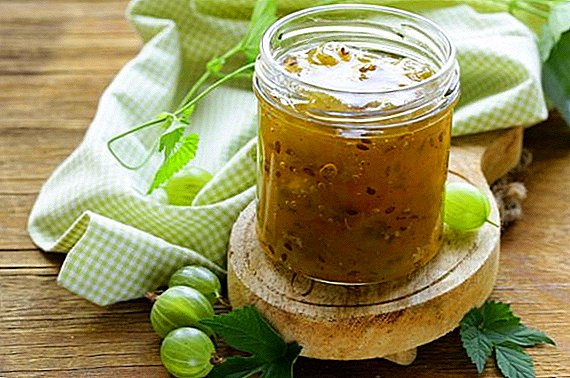
Everyone knows about the benefits of spinach and do not deny this fact. However, in spite of this, he is not a frequent visitor to the beds of modern gardeners. This is due to the fact that many are not familiar with the rules of growing and caring for spinach in the open field.
And from ignorance believe that this is a time-consuming process. In this article you will learn everything about how to plant spinach seeds in the country or garden, whether you need to soak them beforehand, and also see how this crop looks in the photo.
When to plant: in spring, summer and autumn
In the spring, due to early color flow and a tendency to fast-stemming, early-maturing varieties such as Godri, Virofle, Giant, Spokane are planted.
Reference! Also for the spring planting in March, late-ripening variety Victoria will be suitable, since the stem of this variety develops slowly.
For planting in the summer, the end of May - the beginning of June, the best suited spinach Stoik or Sturgeon. It is in the summer, these varieties give high yields.
For planting in late autumn in November, suitable varieties such as Zhirolistny, Korenta, Blyumselsky due to their resistance to tsvetushnosti.
 It is worth noting the versatility of the variety Matador, which can be planted from early spring in March to late autumn in November. It is resistant to low temperatures and has a minimal lateness later.
It is worth noting the versatility of the variety Matador, which can be planted from early spring in March to late autumn in November. It is resistant to low temperatures and has a minimal lateness later.
There are also varieties that are grown only through seedlings or seeds.
When growing seedlings use thermophilic varieties of New Zealand or Matador. Seeds for seedlings sown in March or early April.
For growing seeds using varieties of Victoria, Giant, Matador and Berry. They are the most popular. These varieties can be grown all year round in a greenhouse. In the open ground, these varieties are sown from March to June. For autumn harvest - in mid-August, for the winter - sown in September or October.
Where it is better to do: in the shade or in the sun
For growing spinach is best suited well-lit area where there is no stagnation of water. That is, it should be located on a small elevation. A special feature of spinach is its shade tolerance. It can be safely planted in the shade or dimly lit place.
Leaf plates will be powerful, but remain tender and there will be no bitterness in them. To make the crop appear as soon as possible, plant spinach on the southern slopes.that are protected from the cold wind. If the whole area is in a lowland, then sowing is carried out in the beds, fenced with boards.
A special feature of spinach is compatibility with most of the inhabitants of the garden. Therefore, no need to think about predecessors growing on the site. But what you should pay attention to is the number of feedings made. The more top dressings were made for the previous plant, the better for spinach. The site will fit after any vegetable culture, except for beets.
How to prepare the soil?
Best for spinach fit loose nutrient soil. That is, loamy or sandy soil with low acidity. You can not plant a plant in a limestone soil. In such a ground, its growth will slow down. To improve the structure of the soil, it is necessary to pre-bring rotted manure.
If the soil meets all the requirements for planting, the following steps should be taken.:
- In the fall to make in the soil phosphate-potassium fertilizers.
- Add half doses of nitrogen fertilizer, and the second half - in the spring.
- If the soil is too poor, then before sowing on 1 m2 make 5 g of phosphorus, 7-9 g of nitrogen and 10-12 g of potassium.
Varieties for growing on the site
In terms of harvest, all varieties of spinach are divided into: early, mid-season and late-ripening varieties. The best early ripe varieties for planting in open ground:
- Virofle;
- Godri;
- Marquis;
- Gigantic;
- Stoic.
Mid-season varieties for open ground:
- Blumsdelsky;
- Mariska;
- Burly;
- Matador;
- Leafy.
Late-ripening varieties for cultivation in the open field:
- Victoria;
- Korent;
- Spokane.
A photo
Then you will see how this culture looks in the photo:





Seeds
How to select and process the seeds, is it necessary to soak?
Before planting, you need to select high-quality seeds and prepare them. Selection of seeds is carried out manually. Choose seeds for which there are no defects. Next, they need to soak in warm water. Spinach seeds have a very hard shell, so they need to soak for 24-48 hours.
Seeds will be ready for planting when this shell is softened by water. You need to put the seed container in a warm place and periodically change the water. After the seeds are softened, they are taken out of the water, slightly dried.
Next, make a disinfection with manganese solution. Soak the selected seeds in a 1% solution of manganese for 20 minutes. After washed with water and proceed directly to the landing.
How to sow?
For planting seeds in open ground, perform such actions:
- Loosen the soil and level it.
- When disembarking the beds, create a mound and protect it with boards.
- Make rows on the garden bed, maintaining a distance of 15-20 cm between them.
- The distance between plants should be from 7 to 10 cm.
- At 1 m2 use 4-5 grams of seeds.
- Do not plant the plants thickly, this will slow down their growth.
- Dimples in the beds pour warm water.
- Spread the seeds into grooves.
- Cover the seeds with soil.
- Lightly compact the soil.
- In order to reduce the evaporation of moisture and slow down the appearance of weeds, you need to mulch the soil with hay, dry leaves or straw.
We invite you to watch a video on how to sow spinach seeds:
Do you need to re-seeding after some time or after harvest?
In order to get a crop throughout the summer or another long period of time, the seeds can be sown after a while. Produce this seeding after harvesting.
Seedling
 This process begins with growing the seedlings themselves. It is grown in separate containers until the first shoots appear. Next, prepare the seedlings for planting and send it to open ground. When preparing seedlings for planting should be extremely careful, since spinach has a very weak root system.
This process begins with growing the seedlings themselves. It is grown in separate containers until the first shoots appear. Next, prepare the seedlings for planting and send it to open ground. When preparing seedlings for planting should be extremely careful, since spinach has a very weak root system.
Then proceed to the process of planting. In the grooves in the beds on the site drop the seedlings, covered with earth, compacted and watered with warm water.
Care at first
Spinach care is very simple. It consists in thinning, proper watering and plant nutrition.
Thinning
The first procedure should be carried out after the appearance of the second true leaflet. Further when thickened, thinning is performed so that the plants receive the required amount of oxygen.
Watering
It should be regular. Three liters of liquid are needed per meter. This watering should be carried out 2-3 times a week. When dry and hot weather spend abundant watering.
Top dressing
If the plant shows poor growth, then nitrogen fertilizers must be applied during irrigation. Potash or phosphate fertilizers cannot be used as top dressing.
What plants are best adjoined to?
Spinach is able to take root with any plants, but best with potatoes, tomatoes, beans, radishes and kohlrabi.
What to plant before and after?
Spinach precursors can be potatoes, cucumbers, tomatoes, peppers, and zucchini. To avoid soil depletion, spinach is grown in one area after a break of 3-4 years. After spinach, for the rest of the soil, you can plant Jerusalem artichoke, rutabaga, radish or radish, daikon, katran, turnip or any other tuberous or root crops.
Love to experiment with your health with your favorite dishes, then spinach is perfect for you. Unpretentious plant, with proper cultivation and care, will become an indispensable tool in creating culinary masterpieces. Besides spinach will help strengthen the body with a wide variety of beneficial substances.which are stored in it.


